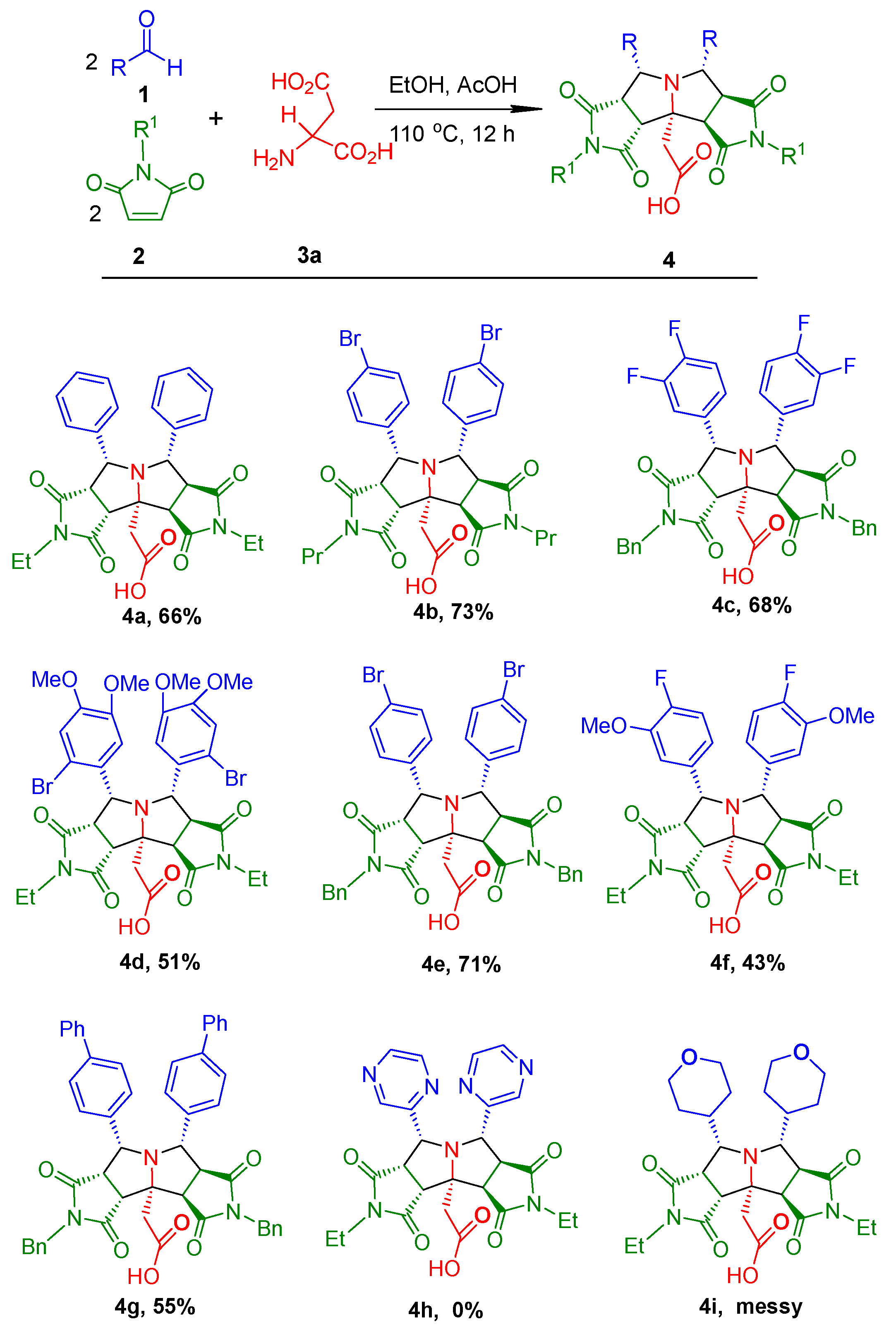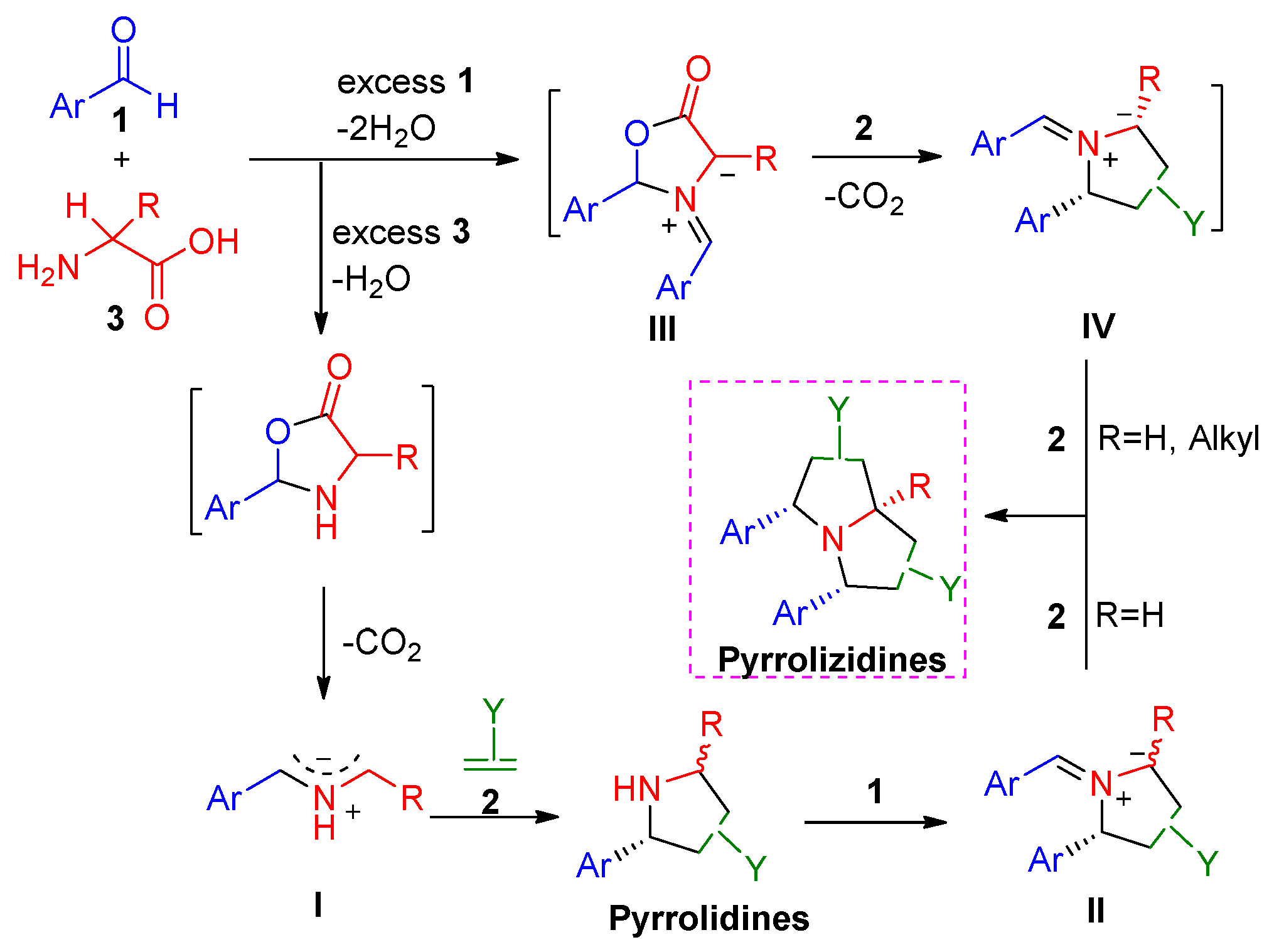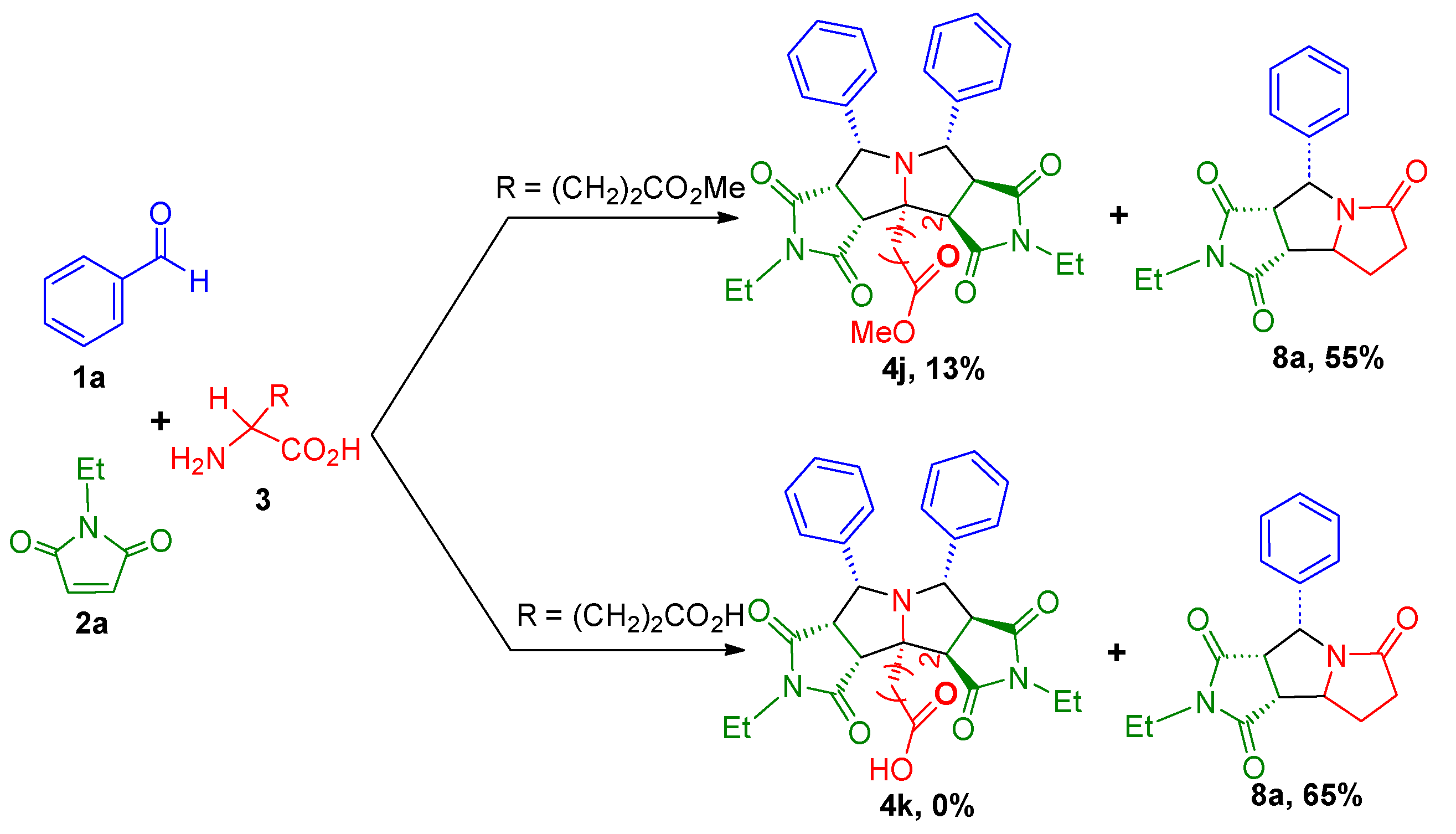Decarboxylation-Driven Double Annulations: Innovative Multi-Component Reaction Pathways
Abstract
:1. Introduction
2. Results and Discussion
3. Materials and Methods
4. Conclusions
Supplementary Materials
Author Contributions
Funding
Institutional Review Board Statement
Informed Consent Statement
Data Availability Statement
Conflicts of Interest
References
- Dömling, A.; Wang, W.; Wang, K. Chemistry and Biology of Multicomponent Reactions. Chem. Rev. 2012, 112, 3083–3135. [Google Scholar] [CrossRef] [PubMed]
- Ganem, B. Strategies for Innovation in Multicomponent Reaction Design. Acc. Chem. Res. 2009, 42, 463–472. [Google Scholar] [CrossRef]
- Yadav, M.S.; Rajkhowa, S.; Singh, S.K.; Jaiswal, M.K.; Tiwari, V.K. Multicomponent Click Reaction: An Indispensable Tool for Easy Access of Functionalized 1,2,3-Triazoles. ChemistrySelect 2024, 9, e202400776. [Google Scholar] [CrossRef]
- Ruijter, E.; Orru, R.V.A. Discovery of MCRs. In Multicomponent Reactions in Organic Synthesis, 1st ed.; Zhu, J.P., Wang, Q., Wang, M.X., Eds.; Wiley: Amsterdam, The Netherlands, 2014; pp. 13–38. [Google Scholar] [CrossRef]
- Preeti; Singh, K.N. Multicomponent Reactions: A Sustainable Tool to 1,2- and 1,3-Azoles. Org. Biomol. Chem. 2018, 16, 9084–9116. [Google Scholar] [CrossRef]
- Jiang, B.; Rajale, T.; Wever, W.; Tu, S.J.; Li, G. Multicomponent Reactions for the Synthesis of Heterocycles. Chem. Asian J. 2010, 5, 2318–2335. [Google Scholar] [CrossRef]
- Sikandar, S.; Zahoor, A.F.; Ghaffar, A.; Anjum, M.N.; Noreen, R.; Irfan, A.; Munir, B.; Kotwica-Mojzych, K.; Mojzych, M. Unveiling the Chemistry and Synthetic Potential of Catalytic Cycloaddition Reaction of Allenes: A Review. Molecules 2023, 28, 704. [Google Scholar] [CrossRef] [PubMed]
- Benjamin, H.; Rotstein, B.H.; Zaretsky, S.; Rai, V.; Yudin, A.K. Small Heterocycles in Multicomponent Reactions. Chem. Rev. 2014, 114, 8323–8359. [Google Scholar] [CrossRef]
- John, S.E.; Gulati, S.; Shankaraiah, N. Recent Advances in Multi-Component Reactions and Their Mechanistic Insights: A Triennium Review. Org. Chem. Front. 2021, 8, 4237–4287. [Google Scholar] [CrossRef]
- Moyano, A.; Rios, R. Asymmetric Organocatalytic Cyclization and Cycloaddition Reactions. Chem. Rev. 2011, 111, 4703–4832. [Google Scholar] [CrossRef]
- Appukkuttan, P.; Mehta, V.P.; Van der Eycken, E.V. Microwave-assisted Cycloaddition Reactions. Chem. Soc. Rev. 2010, 39, 1467–1477. [Google Scholar] [CrossRef]
- Nájera, C.; Sansano, J.M.; Yus, M. 1,3-Dipolar Cycloadditions of Azomethine Imines. Org. Biomol. Chem. 2015, 13, 8596–8636. [Google Scholar] [CrossRef] [PubMed]
- Perreault, S.; Rovis, T. Multi-Component Cycloaddition Approaches in the Catalytic Asymmetric Synthesis of Alkaloid Targets. Chem. Soc. Rev. 2009, 38, 3149–3159. [Google Scholar] [CrossRef]
- Zhang, X.; Qiu, W.; Evans, J.; Kaur, M.; Jasinski, J.P.; Zhang, W. Double 1,3-Dipolar Cycloadditions of Two Nonstabilized Azomethine Ylides for Polycyclic Pyrrolidines. Org. Lett. 2019, 21, 2176–2179. [Google Scholar] [CrossRef]
- Zhang, X.; Qiu, W.; Murray, S.A.; Zhan, D.; Evans, J.; Jasinski, J.P.; Wang, X.; Zhang, W. Pseudo-Five-Component Reaction for Diastereoselective Synthesis of Butterfly Shaped Bispiro[Oxindole-Pyrrolidine]s. J. Org. Chem. 2021, 86, 17395–17403. [Google Scholar] [CrossRef] [PubMed]
- Zhan, D.; Yao, B.; Huan, C.; Lu, J.; Ji, Y.; Zhang, X. A Step-Economical and Diastereoselective Synthesis of Dispirooxindole-Pyrrolizines bearing Seven Stereocenters. Tetrahedron Lett. 2023, 126, 154638. [Google Scholar] [CrossRef]
- Cui, P.; Xu, L.; Shi, Z.; Gan, L. Synthesis of Decahydropyrrolo [2,1,5-cd]indolizine through Consecutive [2+3] Cycloadditions and 6-Exo-Trig Cyclization. J. Org. Chem. 2011, 76, 4210–4212. [Google Scholar] [CrossRef]
- Lu, Q.; Song, G.; Jasinski, J.P.; Keeley, A.C.; Zhang, W. One-pot Double [3+2] Cycloaddition for Diastereoselective Synthesis of Tetracyclic Pyrrolidine Compounds. Green Chem. 2012, 14, 3010–3012. [Google Scholar] [CrossRef]
- Veronica Selva, V.; Larrañaga, O.; Castello, L.M.; Najera, C.; Sansano, J.M.; Cozar, A. Diastereoselective [3+2] vs. [4+2] Cycloadditions of Nitroprolinates with α,β-Unsaturated Aldehydes and Electrophilic Alkenes: An Example of Total Periselectivity. J. Org. Chem. 2017, 82, 6298–6312. [Google Scholar] [CrossRef]
- Zhang, X.; Qiu, W.; Ma, X.; Evans, J.; Kaur, M.; Jasinski, J.P.; Zhang, W. One-Pot Double [3+2] Cycloadditions for Diastereoselective Synthesis of Pyrrolidine-Based Polycyclic Systems. J. Org. Chem. 2018, 83, 13536–13542. [Google Scholar] [CrossRef]
- Cantero, T.M.; Silva Junior, P.I.; Negri, G.; Nascimento, R.M.; Mendonca, R.Z. Antimicrobial Activity of Flavonoids Glycosides and Pyrrolizidine Alkaloids from Propolis of Scaptotrigona aff. Postica. Toxin Rev. 2023, 42, 300–315. [Google Scholar] [CrossRef]
- Schramm, S.; Kohler, N.; Rozhon, W. Pyrrolizidine Alkaloids: Biosynthesis, Biological Activities and Occurrence in Crop Plants. Molecules 2019, 24, 498. [Google Scholar] [CrossRef]
- Fayed, M.A.A. Heliotropium; a Genus Rich in Pyrrolizidine Alkaloids: A Systematic Review Following its Phytochemistry and Pharmacology. Phytomed. Plus 2021, 1, 100036. [Google Scholar] [CrossRef]
- Chen, T.; Mei, N.; Fu, P.P. Genotoxicity of pyrrolizidine alkaloids. J. Appl. Toxicol. 2010, 30, 183–196. [Google Scholar] [CrossRef]
- Jayawickreme, K.; Swistak, D.; Ozimek, E.; Reszczynska, E.; Rysiak, A.; Maluch-Kocka, A.; Hanaka, A. Pyrrolizidine Alkaloids—Pros and Cons for Pharmaceutical and Medical Applications. Int. J. Mol. Sci. 2023, 24, 16972. [Google Scholar] [CrossRef] [PubMed]
- Robertson, J.; Stevens, K. Pyrrolizidine Alkaloids: Occurrence, Biology, and Chemical Synthesis. Nat. Prod. Rep. 2017, 34, 62–89. [Google Scholar] [CrossRef]
- Moreira, R.; Pereira, D.M.; Valentão, P.; Andrade, P.B. Pyrrolizidine Alkaloids: Chemistry, Pharmacology, Toxicology and Food Safety. Int. J. Mol. Sci. 2018, 19, 1668. [Google Scholar] [CrossRef]
- Fan, Y.; Wang, M.; Zhang, Q.; Ouyang, S.; Mao, W.; Xu, C.; Wang, M.; Long, C. Traditional Uses, Phytochemistry, Pharmacology, Toxicity and Clinical Application of Traditional Chinese Medicine Cynoglossum Amabile: A Review. Front. Pharmacol. 2024, 15, 1325283. [Google Scholar] [CrossRef]
- Ma, X.; Qiu, W.; Liu, L.; Zhang, X.; Awad, J.; Evans, J.; Zhang, W. Synthesis of Tetrahydropyrrolothiazoles through One-Pot and Four-Component N,S-Acetalation and Decarboxylative [3+2] Cycloaddition. Green Synth. Catal. 2021, 2, 74–77. [Google Scholar] [CrossRef]
- Zhang, X.; Zhang, W. PASE Synthesis of Pyrrolidine-Containing Heterocycles Through [3+2] Cycloaddition-Initiated Reactions. Curr. Opin. Green Sustain. Chem. 2018, 11, 65–69. [Google Scholar] [CrossRef]
- Yi, W.B.; Zhang, W. Pot, Atom, and Step Economy (PASE) Synthesis; Springer: Cham, Switzerland, 2019. [Google Scholar]
- Zhang, X.; Ma, X.; Zhang, W. Decarboxylative 1,3-Dipolar Cycloaddition of Amino Acids for the Synthesis of Heterocyclic Compounds. Beilstein J. Org. Chem. 2023, 19, 1677–1693. [Google Scholar] [CrossRef]
- Zhou, T.; Zhang, X.; Zhan, D.; Zhang, W. Glycine-Based [3+2] Cycloaddition for the Synthesis of Pyrrolidine-Containing Polycyclic Compounds. Molecules 2024, 29, 5726. [Google Scholar] [CrossRef] [PubMed]
- Chen, W.; Ma, L.; Paul, A.; Seidel, D. Direct α-C–H Bond Functionalization of Unprotected Cyclic Amines. Nat. Chem. 2018, 10, 165–169. [Google Scholar] [CrossRef] [PubMed]
- Seidel, D. The Azomethine Ylide Route to Amine C–H Functionalization: Redox-Versions of Classic Reactions and a Pathway to New Transformations. Acc. Chem. Res. 2015, 48, 317–328. [Google Scholar] [CrossRef]
- Pearson, W.H.; Walters, M.A.; Oswell, K.D. Intramolecular 2-Azaallyl Anion Cycloadditions. Application to the Synthesis of Fused Bicyclic Pyrrolidines. J. Am. Chem. Soc. 1986, 108, 2769–2771. [Google Scholar] [CrossRef]
- Vedejs, E.; West, F.G. Ylides by the Desilylation of α.-Silyl Onium Salts. Chem. Rev. 1986, 86, 941–955. [Google Scholar] [CrossRef]
- Clark, R.B.; Pearson, W.H. Nonstabilized N-Unsubstituted Azomethine Ylides: A Synthesis of Indolizidine 239CD. Org. Lett. 1999, 1, 349–351. [Google Scholar] [CrossRef] [PubMed]
- Takano, Y.; Herranz, M.Á.; Martín, N.; Radhakrishnan, S.G.; Guldi, D.M.; Tsuchiya, T.; Nagase, S.; Akasaka, T. Donor−Acceptor Conjugates of Lanthanum Endohedral Metallofullerene and π-Extended Tetrathiafulvalene. J. Am. Chem. Soc. 2010, 132, 8048–8055. [Google Scholar] [CrossRef]
- Hölzel, H.; Haines, P.; Kaur, R.; Lungerich, D.; Jux, N.; Guldi, D.M. Probing Charge Management across the π-Systems of Nanographenes in Regioisomeric Electron Donor–Acceptor Architectures. J. Am. Chem. Soc. 2022, 144, 8977–8986. [Google Scholar] [CrossRef]







| Entry | Solvent | T1 (°C) | t1 (h) | 4a (%) b | Dr c |
|---|---|---|---|---|---|
| 1 | EtOH | 90 | 6 | 53 | 4:1 |
| 2 | EtOH | 90 | 12 | 60 | 4:1 |
| 3 | EtOH | 110 | 12 | 71 (66) | 4:1 |
| 4 | EtOH | 125 | 12 | 63 | 4:1 |
| 5 d | EtOH | 110 | 12 | 55 | 3:1 |
| 6 | MeCN | 110 | 12 | 46 | 4:1 |
| 7 | MeOH | 85 | 24 | 39 | 3:1 |
Disclaimer/Publisher’s Note: The statements, opinions and data contained in all publications are solely those of the individual author(s) and contributor(s) and not of MDPI and/or the editor(s). MDPI and/or the editor(s) disclaim responsibility for any injury to people or property resulting from any ideas, methods, instructions or products referred to in the content. |
© 2025 by the authors. Licensee MDPI, Basel, Switzerland. This article is an open access article distributed under the terms and conditions of the Creative Commons Attribution (CC BY) license (https://creativecommons.org/licenses/by/4.0/).
Share and Cite
Zhan, D.; Yang, G.; Zhou, T.; Nallapati, S.; Zhang, X. Decarboxylation-Driven Double Annulations: Innovative Multi-Component Reaction Pathways. Molecules 2025, 30, 1594. https://doi.org/10.3390/molecules30071594
Zhan D, Yang G, Zhou T, Nallapati S, Zhang X. Decarboxylation-Driven Double Annulations: Innovative Multi-Component Reaction Pathways. Molecules. 2025; 30(7):1594. https://doi.org/10.3390/molecules30071594
Chicago/Turabian StyleZhan, Desheng, Gang Yang, Tieli Zhou, Sashirekha Nallapati, and Xiaofeng Zhang. 2025. "Decarboxylation-Driven Double Annulations: Innovative Multi-Component Reaction Pathways" Molecules 30, no. 7: 1594. https://doi.org/10.3390/molecules30071594
APA StyleZhan, D., Yang, G., Zhou, T., Nallapati, S., & Zhang, X. (2025). Decarboxylation-Driven Double Annulations: Innovative Multi-Component Reaction Pathways. Molecules, 30(7), 1594. https://doi.org/10.3390/molecules30071594







